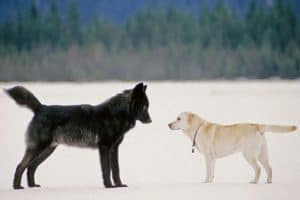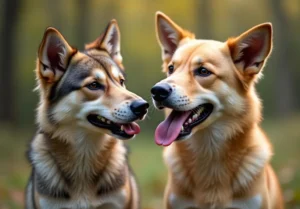Cats and dogs: two beloved pets in many households, but why are they often portrayed as enemies? The rivalry between these two animals has been a subject of fascination and curiosity for pet owners and animal lovers alike. Let’s delve into the reasons behind this age-old feud.
Evolutionary Differences
Cats and dogs have a long history of rivalry due to their evolutionary differences. Cats are solitary hunters, descended from wild felines that needed to fend for themselves. This has made them independent and territorial by nature. On the other hand, dogs are pack animals, originating from wolves that relied on teamwork to survive. This pack mentality instills in them a strong need for social hierarchy and structured order.
These inherent differences in their evolutionary backgrounds can create tension when cats and dogs interact. Cats may see dogs as intruders threatening their territory, while dogs may view cats as prey or competition. Understanding these fundamental instinctual behaviors can help pet owners navigate the dynamic between their feline and canine companions.
Communication Styles
Communication plays a crucial role in the relationship between cats and dogs. Communication styles vary between the two species, leading to potential conflicts and misunderstandings. Cats primarily rely on body language, subtle cues, and vocalizations to express themselves. They are known for their independent and sometimes aloof demeanor.
On the contrary, dogs are more vocal and expressive in their communication, using barks, growls, and tail wagging to convey their emotions and intentions. They are pack animals that thrive on social interactions and clear signals within their group. This stark contrast in communication styles can often create confusion and tension between cats and dogs in shared environments.
Tips for Pet Owners:
- Provide separate spaces for your cat and dog to retreat to when needed.
- Socialize them early on to help them understand each other’s behaviors.
- Monitor their interactions and intervene if signs of tension arise.
By recognizing and respecting the evolutionary differences and communication styles of cats and dogs, pet owners can foster a harmonious environment for their beloved pets to coexist peacefully.
Territory and Dominance
Cats and dogs have a natural instinct to establish and protect their territory. When a cat or a dog feels like their space is being invaded, tensions can rise. Cats are more independent and solitary animals, often claiming a certain territory as their own. On the other hand, dogs are pack animals that establish a hierarchy within their group. When a cat and a dog are introduced in the same household, their territorial instincts can clash, leading to potential conflicts over space and dominance. This can result in aggression and animosity between the two species.
Additionally, cats and dogs communicate differently when it comes to establishing boundaries. Cats may use subtle body language cues or vocalizations to convey their territorial rights, while dogs may rely more on direct physical displays of dominance. These differences in communication styles can further exacerbate misunderstandings between cats and dogs, adding fuel to the fire of their enmity.
Unique Insight: Providing separate spaces within the home for both cats and dogs can help reduce territorial conflicts. Having designated areas where each pet feels safe and secure can minimize tension and promote harmony in a multi-species household.
Prey Drive
Cats and dogs are both natural hunters with strong prey drives. Cats are solitary hunters that rely on stealth and agility to catch small prey like mice and birds. Dogs, on the other hand, are pack hunters that use teamwork and endurance to bring down larger prey. When cats and dogs interact, their predatory instincts can be triggered, potentially leading to aggressive behavior towards one another.
In some cases, a cat’s quick movements or high-pitched vocalizations may activate a dog’s prey drive, causing the dog to chase or even attack the cat. Similarly, a cat may see a dog as a threat to its territory or food source, prompting defensive actions that can escalate into a confrontation. These primal instincts are deeply ingrained in both species, making it challenging to completely eliminate the potential for conflict between cats and dogs.
To prevent altercations between cats and dogs, it is essential to provide proper supervision and training for both pets. Teaching dogs to control their prey drive and cats to assert their boundaries can help manage their interactions and foster a more peaceful coexistence in a shared environment. Remember, understanding and respecting each pet’s natural instincts is key to promoting a harmonious relationship between cats and dogs.
Human Influence
Human interventions, such as bringing cats and dogs into the same household, can significantly impact their relationship dynamic. When cats and dogs are not properly introduced to each other or if they feel threatened by the other pet’s presence, it can lead to tension and rivalry between them. To foster a peaceful coexistence, it’s essential for pet owners to provide a safe and harmonious environment for both animals. This can include creating separate spaces for each pet to retreat to, implementing positive reinforcement training techniques, and offering plenty of mental and physical stimulation to prevent boredom and aggression.
Socialization
Proper socialization plays a crucial role in shaping the relationship between cats and dogs. Early exposure to each other in a controlled and positive environment can help alleviate potential animosity between the animals. By gradually introducing them to one another and monitoring their interactions, pet owners can help build mutual trust and understanding. Without early socialization, cats and dogs may struggle to communicate effectively and may perceive each other as threats, leading to conflicts. Providing supervised play sessions, positive reinforcement, and rewards for calm behavior can help establish a foundation of respect and companionship between the pets.
Additional Tip:
– Gradual Introductions: When introducing a new cat or dog into a household with existing pets, take it slow. Allow them to get acquainted with each other’s scent first before progressing to visual interactions. This gradual approach can help reduce stress and anxiety for both animals.
Mythbusting: Can Cats and Dogs Get Along?
Let’s debunk the myth that cats and dogs are natural enemies. While it’s true that they have different communication styles and social structures, with a bit of patience and understanding, they can actually form strong bonds.
Contrary to popular belief, cats and dogs can get along well if introduced properly. It’s important to start slow and allow them to acclimate to each other’s presence. Providing separate spaces for each pet initially can help reduce tension and prevent conflicts.
Another misconception is that all cats and dogs will never get along. In reality, many households successfully raise both cats and dogs together peacefully. It often depends on the individual personalities of the pets rather than their species.
To foster a harmonious relationship between your cat and dog, make sure to supervise their initial interactions, offer positive reinforcement for good behavior, and create a safe environment for both pets to coexist. With time and effort, you can help them develop a bond based on mutual respect and companionship.
Top Tips for Fostering a Harmonious Relationship: 1. Slow Introduction: Allow the pets to get used to each other gradually. 2. Supervise Interactions: Monitor their interactions to prevent any conflicts. 3. Positive Reinforcement: Reward good behavior with treats and praise. 4. Create Safe Spaces: Provide separate areas for each pet to retreat to if needed. 5. Patience is Key: Building a strong bond takes time and consistent effort.
Fun Facts
Cat and dog companionship with humans dates back thousands of years, with cats likely being domesticated around 9,000 years ago in the Near East, and dogs around 14,000 years ago in East Asia. Both animals have played integral roles in human society, providing companionship, protection, and assistance in various tasks.
Interestingly, cats were revered in ancient Egypt, with many being considered sacred and even worshipped as gods. Dogs, on the other hand, have been valued for their loyalty, intelligence, and working abilities throughout history. From herding livestock to serving as guide dogs for the visually impaired, dogs have proven to be versatile companions.
Cats are known for their agility, independence, and mysterious nature, while dogs are praised for their loyalty, trainability, and diverse range of breeds suited to different roles. Together, they offer a unique balance of qualities that enrich the lives of their human companions.
Next time you observe your cat and dog interacting, remember the rich history and distinctive characteristics that make them such fascinating and beloved members of our families. Embrace the differences and quirks of each pet, knowing that their dynamic relationship adds joy and diversity to your household.
Alex, a passionate animal lover, has experience in training and understanding animal behavior. As a proud pet parent to two dogs and three cats, he founded AnimalReport.net to share insights from animal experts and expand his knowledge of the animal kingdom.




